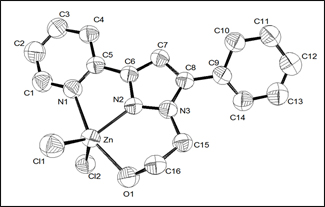Preparation, separation and characterization of two pyrazolic regioisomers of high purity

The coordination chemistry of the pyrazole-derived ligands has been extensively studied in recent years. In our group, we have continued the study of these ligands and we have described the reaction of the ligands with palladium and platinum (Pd(II) and Pt(II)).
The pyrazole ring is present in many pharmacologically important compounds. Although many methods are known for the construction of this ring system, the search for novel synthetic methodology addressing the necessity for a particular regioisomer is always desirable.
In recent years, we have developed general synthesis of 1,3,5-substituted pyrazole derived ligands, and focussed the research on the development of methods for regioselective synthesis. In the present paper, we describe de preparation, separation and characterisation of two regioisomers of a 1,3,5-substituted pyrazole derived ligand (pyrazole1, pyrazole2).
Scheme of pyrazole 2 and pyrazole 1 ligands.
The separation of the regioisomers was carried out by silica column chromatography using ethyl acetate as eluent. These regioisomers were characterised by analytical and spectroscopic techniques. In particular, 1H and 13C{1H} NMR, which have permit calculated the ratio of the regioisomers (43 pyrazole1: 57 pyrazole2). The assignment of each one of the regioisomers was confirmed by NOESY experiments.
Once the two regioisomers were synthesised and characterised, we assayed the reactivity with palladium, platinum and zinc (Pd(II), Pt(II) and Zn(II)), yields [MCl2(pyrazole1)2], cis-[MCl2(pyrazole2)] (M = Pd(II), Pt(II)) and [ZnCl2(L)] (L = pyrazole1, pyrazole2) complexes. The isolated products do not depend on the stoichiometries used in the synthesis of the complexes. All compounds were characterised by analytic, spectroscopic techniques and X-ray crystal structure. The coordination behaviour of both ligands was concluded. Head image shows the structure of the [ZnCl2(pyrazole2)] compound.
The present work enrich the knowledge of the behaviour of two regioisomers ligands toward metals like palladium, platinum and zinc (Pd(II), Pt(II) and Zn(II)), which should be of high importance for their further applications.
References
"Preparation, separation and characterisation of two regioisomers of a N-hydroxyalkylpyridylpyrazole ligand: A structural investigation of their coordination to Pd(II), Pt(II) and Zn(II) centres". Luque, C.; Pons, J.; Calvet, T.; Font-Bardia, M.; García-Antón, J.; Ros, J. Inorganica Chimica Acta. 367 (2011) 35–43.


